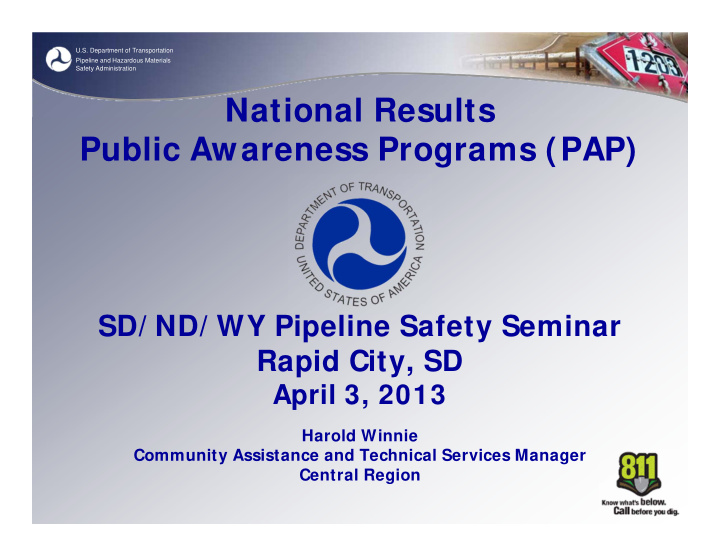



U.S. Department of Transportation Pipeline and Hazardous Materials Safety Administration National Results Public Awareness Programs (PAP) SD/ ND/ WY Pipeline Safety Seminar Rapid City, SD April 3, 2013 Harold Winnie Community Assistance and Technical Services Manager Central Region
U.S. Department of Transportation Pipeline and Hazardous Materials Safety Administration Presentation Overview • PA I nspections – Observed issues – General Observations – Next Steps – W here to go for additional inform ation
U.S. Department of Transportation Pipeline and Hazardous Materials Safety Administration Operator PAP Effectiveness Evaluation (PAPEE) I nspections • Section One - Adm inistration and Developm ent of PAP – Plan/ Process/ Procedures; details on w ho, w hat, w hen, w here, how , w hy • 1 .0 1 W ritten Program • 1 .0 2 Managem ent Support • 1 .0 3 Unique Attributes and Characteristics • 1 .0 4 Stakeholder Audience I dentification • 1 .0 5 Message Frequency and Delivery • 1 .0 6 W ritten Evaluation Plan
U.S. Department of Transportation Pipeline and Hazardous Materials Safety Administration Section Two Documentation/ Records for implementing program • Message Content: � Pipeline Purpose and Reliability � Hazard Aw areness and Prevention Measures � Leak Recognition and Response � Em ergency Preparedness Com m unications � Dam age Prevention � Pipeline Location I nform ation � Gas Transm ission Operators - Overview of I MP and HCA � Operator W ebsites � ROW Encroachm ent Prevention � Planned Pipeline Maintenance/ Construction Activities � Security � Facility Purpose
U.S. Department of Transportation Pipeline and Hazardous Materials Safety Administration Section Two Documentation/ Records for implementing program • 2 .0 1 : English and other Languages ( process) • 2 .0 2 : Message Type and Content ( m essage m apping) • 2 .0 3 : Messages on Pipeline Facility Locations • 2 .0 4 : Baseline Message Delivery Frequency – Per API RP 1 1 6 2 • 2 .0 5 : Consideration for Supplem ental Program Enhancem ents ( schools, special situations) • 2 .0 6 : Maintaining Liaison w / Em ergency Response Officials ( periodic contact)
U.S. Department of Transportation Pipeline and Hazardous Materials Safety Administration Communication is Essential • The m ost im portant aspects of pipeline em ergency preparedness and response are com m unication, coordination and cooperation betw een pipeline operators and stakeholders • There is no substitute for establishing positive w orking relationships before em ergencies occur • Com m unication needs to be tailored specific to pipeline - 6 -
U.S. Department of Transportation Pipeline and Hazardous Materials Safety Administration Section Three Annual Audits (Program Evaluation & Continuous I mprovement) • 3 .0 1 Measuring Program I m plem entation • 3 .0 2 Acceptable Methods for Program I m plem entation Audits • 3 .0 3 Program Changes and I m provem ents
U.S. Department of Transportation Pipeline and Hazardous Materials Safety Administration Section Four Program Evaluation & Continuous I mprovement (Effectiveness) • Understand Sam ple Size and Margin of Error • A sam ple calculator/ confidence level softw are. • http:/ / w w w .raosoft.com / sam plesize.htm l
U.S. Department of Transportation Pipeline and Hazardous Materials Safety Administration Section Four Program Evaluation & Continuous I mprovement (Effectiveness) • 4 .0 1 Evaluating Program Effectiveness • 4 .0 2 Measure Program Outreach • 4 .0 3 Measure Percentage Stakeholders Reached • 4 .0 4 Measure Understandability of Message Content • 4 .0 5 Measure Desired Stakeholder Behavior • 4 .0 6 Measure Bottom -Line Results • 4 .0 7 Program Changes
U.S. Department of Transportation Pipeline and Hazardous Materials Safety Administration For Program Effectiveness… • Information Reaching Intended Stakeholders • Stakeholders understanding messages • Stakeholders motivated to respond appropriately • Implementation impacting bottom-line results Survey (data collection tool) Com pleted Assessment Data Effectiveness Effectiveness Evaluation Data Evaluation
U.S. Department of Transportation Pipeline and Hazardous Materials Safety Administration General Observations • Most operators putting forth effort and im proving program s w ith creative approaches • Need m ore detailed procedures • Process m ethodology im provem ents are needed w ith annual audits/ effectiveness evaluations • Motivating stakeholders to stop, listen, and change • Balancing inform ation overload w ith specific m essages Continuous I m provem ent Efforts Are Not I n Vain!
U.S. Department of Transportation Pipeline and Hazardous Materials Safety Administration Updates • PHMSA I nspectors w rapping up PAPEE I nspections and I nspection Reports • Planning a Public Aw areness W orkshop: – 2 0 1 3 ( Date & Location TBD) – Bringing stakeholders together – I nspection Analysis – Advancing Public Aw areness ( im provem ents) • I dentify recom m endations after w orkshop for changes to: – Federal regulations – API RP 1 1 6 2
U.S. Department of Transportation Pipeline and Hazardous Materials Safety Administration Additional I nformation • Public Aw areness Stakeholder Com m unications https: / / primis.phmsa.dot.gov/ comm/ PublicAwareness/ PublicA wareness.htm I ncludes inform ation on: - Regulatory Requirem ents - API RP 1 1 6 2 - PA W orkshops - I nspection Form and Guidance Docum ents - FAQs
U.S. Department of Transportation Pipeline and Hazardous Materials Safety Administration Questions Thank you!
U.S. Department of Transportation Pipeline and Hazardous Materials Safety Administration Thank You Harold W innie ( 8 1 6 ) 3 2 9 -3 8 3 6 Harold.W innie@dot.gov
Recommend
More recommend